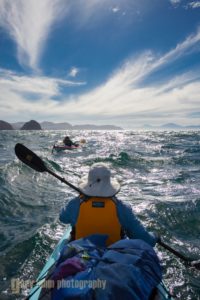Why Agile Strategy is Like Ocean Kayaking
Today, organizations of all types are facing an uncertain future. While we hope for calm times in which we can make steady progress, we know that turbulence can arise at any moment and throw us off course.

Our journey is not unlike the ocean kayaker. Offshore breezes can fire up at any time, and they will. When they do, it’s difficult to return to shore. When you kayak on the ocean, anything can happen. If you flip over and find yourself underwater, it’s scary if you don’t know what to do. So here are some simple lessons:
- Practice maneuvering your kayak in calm water. You need to develop your paddling skills. You need to master some of the steering strokes. You need to learn how to brace to maintain your stability. And, yes, you need to practice how to get out of your boat quickly if you flip over.
- When you venture out from calm water, always be aware of the weather. If it turns more turbulent, you need to be more vigilant. Pick your head up more frequently and make judgments about how you can best get to where you want to go. The wind, wave action, the tides and currents all influence where you are heading.
- Stay relaxed. A death grip on your paddle won’t help your progress. You can find your way out if you rely on your skills, stay present and aware, and remember that you can’t mess with the power of the ocean.
- Never forget that your most stable position comes when you are moving forward. Don’t stop paddling.
Agile strategy embraces some of the same principles. It’s a collective, shared discipline of thoughtful action. A team blends thinking and doing in order to move forward. Excessive planning won’t help.
A kayaker cannot figure out all the complex forces acting on her boat by sitting on the beach and thinking about it. She needs to get in the boat and start paddling.
The same is true for organizations. Complex, agile strategies emerge from a simple set of principles and shared habits. Collaboration is the core of agility. Like paddling a kayak, it involves a portfolio of sophisticated skills that only improves with practice.
As collaboration skills broaden and deepen, your organization becomes more agile. With practice, your team becomes more confident of making progress in turbulence. You build shared skills to make judgements based on always incomplete information. You move based on what you know now.
You push aside anxieties. While you carefully consider risks, they do not become excuses for standing still. You learn when to press forward and when to brace. You make decisions confident in your ability to correct your course. You commit to your experiments, and you learn from them. You focus on remaining vigilant, aware and decisive.
Old habits of strategic planning won’t work in these increasingly turbulent environments. Excessive analysis leads to confusion, excuses, exhaustion. Words decoupled from action become worthless. So, for example, just saying, “We need to collaborate to innovate” won’t make you any more prepared. Facing a turbulent ocean, a kayaker cannot rely on wishful thinking, exhortation, aphorisms, or clever phrases.
She must think and do. Above all, relying on the skills she has practiced, she must push her anxieties aside and keep paddling.

The Founder of the Lab at UNA and co-author of Strategic Doing: 10 Skills for Agile Leadership, Ed’s work has focused on developing new models of strategy specifically designed to accelerate complex collaboration in networks and open innovation. He is the original developer of Strategic Doing.
